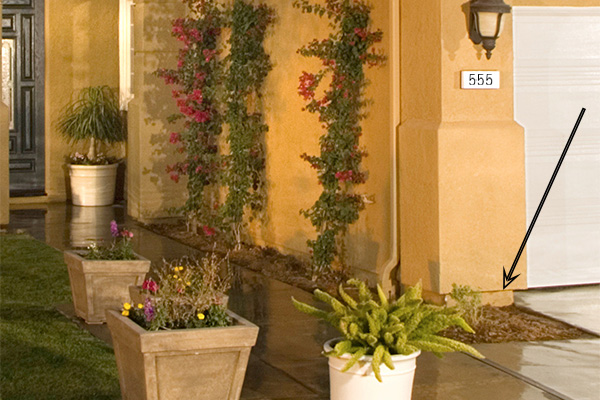Prevention
Protecting your home from wood-destroying organisms starts with keeping wood as dry and well-sealed as possible. Moisture creates the ideal environment for termites, dryrot, and other pests to thrive. Here are some essential tips to safeguard your property:
- Repair Leaks Promptly: Whether it's a plumbing issue or a roof leak, addressing water intrusions quickly prevents moisture buildup and potential damage.
- Ensure Proper Drainage: Water should always be directed away from your home. Check that gutters and downspouts are clear of debris like leaves to allow rainwater to flow freely.
- Mind Soil Levels Around Your Home: Avoid piling soil too high against walls framed with wood. Water often gets behind stucco or siding and must be able to drain properly. Your weep screed—the gap that allows water to escape—should sit at least 4 inches above soil or 2 inches above concrete.
- Be Cautious with Plants Next to the House: Planter beds should not be higher than the wood framing in your walls. Elevated soil can trap moisture and compromise the protective barriers designed to keep your walls dry.
- Maintain Exterior Wood: Regularly inspect and repaint or reseal wood surfaces on your home’s exterior to create a strong barrier against moisture and wood-destroying pests.

Preventing Drywood Termite Infestations
Taking steps to prevent drywood termites during construction or in existing homes can save homeowners from costly repairs down the road.
Pre-Construction Prevention
When building a new home, the framing stage offers a unique opportunity to apply long-lasting treatments directly to the surfaces of the wood. These preventative measures can protect the structure for the lifetime of the house. However, once the walls are sealed and wood surfaces are painted, access for treatment becomes limited.
Attics: A Vulnerable Area
In Southern California, attics often provide ideal conditions for drywood termites to thrive. Attic vents, in particular, are a common entry point. The screens on these vents are usually large enough for termites to pass through. To mitigate this risk:
- Install Interior Screens: Adding a standard window screen over attic vents from the inside can help block termite entry. Use caulking around the edges to ensure the screen is securely sealed. If your attic is designed to be vented, it’s important to maintain proper airflow to avoid moisture buildup and ensure effective ventilation.
Additional Protective Measures
- Pest Control Insulation: Loose pest control insulation can be blown into the attic. This can either replace the current insulation or be added on top of it to create an extra barrier against termites.
- Wood Treatment: Exposed wood in the attic can also be sprayed with preventative treatments to deter termite activity.

Preventing Wood Damage with the Right Materials
When constructing anything with wood that will be exposed to the elements, choosing the right materials and proper installation methods are key to ensuring durability and safety. Here are some things to consider:
- Use Pressure-Treated Wood: For outdoor projects, pressure-treated wood is an excellent choice because it is treated with chemicals to resist decay, termites, and other pests. This makes it far more durable than untreated wood when exposed to moisture and the elements.
- Avoid Ground Contact: Even with pressure-treated wood, it’s best to ensure the material does not come into direct contact with the ground. Ground contact can accelerate decay and compromise the wood’s longevity.
- Safety Considerations: Pressure-treated wood contains chemicals that can leach out over time. If the wood is installed in areas where people may touch it, such as handrails or seating, it should be painted or sealed to minimize direct contact with the treated surface.
- Consider Non-Wood Alternatives: In many cases, building with non-wood materials can
help prevent issues related to termites, dryrot, and moisture damage altogether. Here are some
popular alternatives:
- Fiber-Cement Board: A strong, durable material (like Hardie products) often used for siding and trim. It resists termites, fungus, and moisture damage.
- Vinyl Products: From siding and soffits to fencing, window trim, and porch ceilings, vinyl is lightweight, low-maintenance, and completely immune to rot and insect damage.
- Engineered Wood Products: Treated to resist termites and decay, these products offer the look of wood with added protection. Common in siding, trim, and paneling.
- PVC and Other Plastic-Based Materials: Used for trim boards, fascia, columns, and decking, these materials don’t absorb moisture and are impervious to insect and fungus damage.
- Composite Products: Blended from recycled wood fibers and plastic, composite materials are used for decking, railings, fence posts, and more. They’re highly durable, low-maintenance, and resistant to rot and pests.
- Aluminum and Other Metals: A long-lasting option for patio covers, trim wraps, and railings.
- Metal Siding and Flashing: Used to protect vulnerable areas and exposed wood surfaces. Helps direct water away and prevents decay over time.